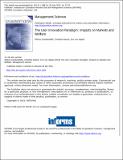The User Innovation Paradigm: Impacts on Markets and Welfare
Author(s)
Gambardella, Alfonso; Raasch, Christina; von Hippel, Eric A.
Downloadvon Hippel_The user.pdf (416.2Kb)
PUBLISHER_CC
Publisher with Creative Commons License
Creative Commons Attribution
Terms of use
Metadata
Show full item recordAbstract
Innovation has traditionally been seen as the province of producers. However, theoretical and empirical research now shows that individual users—consumers—are also a major and increasingly important source of new product and service designs. In this paper, we build a microeconomic model of a market that incorporates demand-side innovation and competition. We explain the conditions under which firms find it beneficial to invest in supporting and harvesting users’ innovations, and we show that social welfare rises when firms utilize this source of innovation. Our modeling also indicates reasons for policy interventions with respect to a mixed user and producer innovation economy. From the social welfare perspective, as the share of innovating users in a market increases, profit-maximizing firms tend to switch “too late” from a focus on internal research and development to a strategy of also supporting and harvesting user innovations. Underlying this inefficiency are externalities that the producer cannot capture. Overall, our results explain when and how the proliferation of innovating users leads to a superior division of innovative labor involving complementary investments by users and producers, both benefitting producers and increasing social welfare.
Date issued
2016-04Department
Sloan School of ManagementJournal
Management Science
Publisher
Institute for Operations Research and the Management Sciences (INFORMS)
Citation
Gambardella, Alfonso, Christina Raasch, and Eric von Hippel. “The User Innovation Paradigm: Impacts on Markets and Welfare.” Management Science (April 4, 2016).
Version: Final published version
ISSN
0025-1909
1526-5501